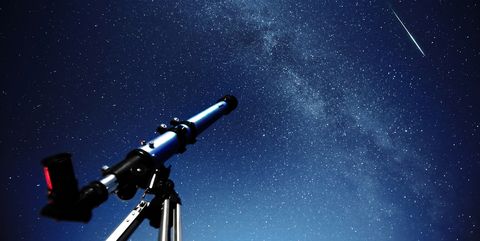With the naked eye you can observe the stars and the constellations and it is also the only way to learn to recognize them by comparing what you see with the maps of a good atlas. You will also be able to observe shooting stars (meteors), artificial satellites, lunar (or solar) eclipses like the one shown on the right, polar auroras, the different phases of the Moon and possibly photographing them.
But if you want to observe craters of the Moon, planets or nebulae you must use an astronomy instrument that will allow you to enlarge the image of objects, as does the telephoto lens of a camera.
The more the objective (the lens or the mirror) of the instrument is bigger the more it will be bright and at most the image will be brilliant. It is also necessary that its focal length, its length, is long enough if you want a large magnification. It is especially important to observe the details, craters of the Moon for example, planets or small galaxies.

A pair of 10×50 binoculars magnifies 10x and has a 50mm diameter lens. It is the ideal to start; especially since you can also use it to observe nature. When you observe an object in a pair of binoculars, I advise you to put your elbows on a table or to support the binoculars against a wall or a tree otherwise you risk to move and to have difficulties to center and observe the object. You can also install the binoculars on a tripod with an adapter; so there will be no risk of moving and you will be able to observe the sky in very good conditions.
Since the magnification of the binoculars is often very small (10x in our example), you will be able to observe vast fields of stars, even more extensive than those which you would see in a small telescope of 60 mm. Indeed, the telescope will grow stronger which will reduce the field of vision.
A pair of binoculars is therefore ideal for viewing large areas of the sky and ideally in a very open area, such as a meadow or altitude area away from any light. Thus, while in the city it is impossible to see the Milky Way in the middle of summer because of light pollution, in the Alps, in the Valle d’Aosta for example to 1500 or 2000 m altitude, you see as much almost only on the photographs. It’s a really beautiful show for which binoculars are all you need. Think about it for your holidays!
On the other hand, the binoculars having a small diameter, the image of the stars remains very small. If you love astronomy, watching planets or galaxies, I suggest you replace your binoculars with an instrument with a larger diameter and longer focal length. You have the choice between the telescope and the telescope.
The telescope consists of a lens lens that aims to collect light and focus it towards the eyepiece that provides magnification. The larger the focal length of the lens, the easier it will be to enlarge the image and the shorter the eyepiece, the higher the magnification.

Ponnu myre
Enn engan
Enough
a
kk
Jojo